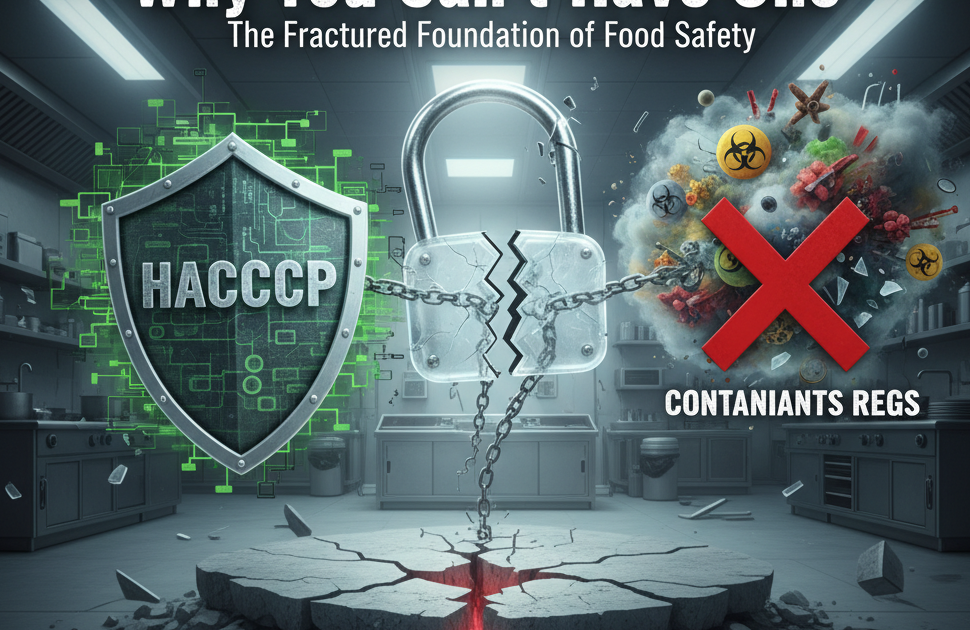HACCP and Contaminants Regulations

HACCP and Contaminants Regulations: Why You Can’t Have One Without the Other in Food Safety
If you’re in the food business, “safety” isn’t just a box-ticking exercise. It’s the bedrock of your reputation. And when it comes to building a rock-solid safety system, two elements have to work in perfect sync: your HACCP plan and the government’s non-negotiable Contaminants Regulations.
It’s tempting to see these as two separate jobs. One is the daily grind of process control (HACCP), and the other is the big, scary legal rulebook (the Regs).
The truth? They are two halves of the same whole. The Regulations tell you the legal finish line you must reach. HACCP is the living, breathing game plan that ensures you actually get there, every single day. Let’s break down how this powerful partnership truly works.
The Rulebook: What Are Food Contaminants Regulations?
First, let’s clear up what the law actually demands. The UK’s Contaminants Regulations set the absolute maximum legal levels for nasty stuff that shouldn’t be in food.
We’re not talking about ingredients. We’re talking about unwanted stowaways—things that get in through environmental pollution, processing, transport, or storage. Think of it as the legal “red line” for safety. Key offenders on this list include:
-
Mycotoxins: Nasty toxins from mould, like aflatoxins in nuts or patulin in bruised apples.
-
Heavy Metals: Lead, cadmium, and mercury creeping in from soil or water.
-
Process Contaminants: Things that actually form during cooking, like acrylamide on that perfectly brown chip.
-
POPs (Persistent Organic Pollutants): Heavy-duty environmental pollutants like dioxins.
This rulebook isn’t a suggestion. If your product is over the limit, it’s illegal. Simple as that.
The Game Plan: How HACCP Actually Does the Work
Knowing the legal limits is one thing. How do you guarantee your entire production run, day in and day out, stays safely under them? That’s where HACCP steps in.
HACCP (Hazard Analysis and Critical Control Points) flips safety management from reactive to proactive. Instead of crossing your fingers and testing the final product (and praying it passes), you build a system that stops the problem from ever happening.
It’s a systematic detective story: you identify every single step where a hazard could occur, and then you put a robust control measure right on that exact spot.
Connecting the Dots: HACCP and Contaminants Regulations in Action
This is where the relationship clicks. Your HACCP plan doesn’t just guess at “what’s dangerous.” It uses the Contaminants Regulations as its primary source of intelligence.
Let’s walk this through. Imagine you’re making strawberry jam.
Analysing the Hazard
Your HACCP team gets together. What’s the risk with strawberries? A big one is ‘patulin’—that mycotoxin from mouldy, damaged fruit. That’s a chemical hazard.
Finding the Legal Target
Okay, so patulin is a risk. How much is too much? The team doesn’t guess. They open the rulebook (the Regulations) and find the exact legal limit set for fruit jams. This number is now their non-negotiable target.
Pinpointing the Control (The CCP)
Where is the single best place to stop patulin from getting into the final jar? It’s not during boiling; it’s right at the beginning—the moment the fruit arrives. That sorting belt becomes your Critical Control Point (CCP).
Setting the Internal Limit
The legal limit is for the final jam. To guarantee you hit that, your CCP limit has to be even stricter. So, the team sets a critical limit: “Zero tolerance for any visible mould or bruising on incoming fruit. Any failed batches are rejected.”
Monitoring and Action
This isn’t just a rule in a binder. Someone physically monitors that sorting belt. If a bad batch is spotted, the corrective action (rejecting the supplier’s lorry) is immediate.
See the connection? The Regulations provided the “what.” HACCP provided the “how, where, and when.”
It’s All About the System
You simply can’t run an effective food safety operation without both. The Regulations provide the legal goalposts, and your HACCP plan is the system you build to ensure you always score. While the principles are clear, mastering this partnership—whether for your own brand or as a contract manufacturer—can be a complex and demanding task.
That’s where our expertise can provide clarity and confidence. Our team of seasoned auditors and food safety consultants specialises in helping businesses like yours build robust HACCP plans that are not only compliant but also practical and efficient. We ensure your systems align perfectly with the latest UK regulations, preparing you for audits and safeguarding your clients’ and your own brand’s reputation.
For professional support with your food safety management systems in the UK, get in touch with our team today. For our partners and contract manufacturers in Turkey, our expert local team is ready to assist you at fevkalite.net.
Got Questions? (FAQs)
Does having a HACCP plan mean I’m automatically compliant with the Regs?
A strong HACCP plan is your best possible defence and proves you’re doing your due diligence. But compliance is ultimately proven by the final product. Regular testing is still needed to verify that your brilliant system is working exactly as you planned.
Do these legal limits ever change?
Yes, they do. Science evolves. The FSA reviews new data and risk assessments, so limits can (and do) get updated. Part of your job is staying on top of those changes.
Can’t I just test my final products instead of all this HACCP hassle?
You could, but it’s a costly and dangerous gamble. You’re effectively betting your entire production run on a single test. What if it fails? A preventative HACCP system stops the problem long before it ever gets near a finished jar, saving you a fortune (and your reputation) in the long run.
